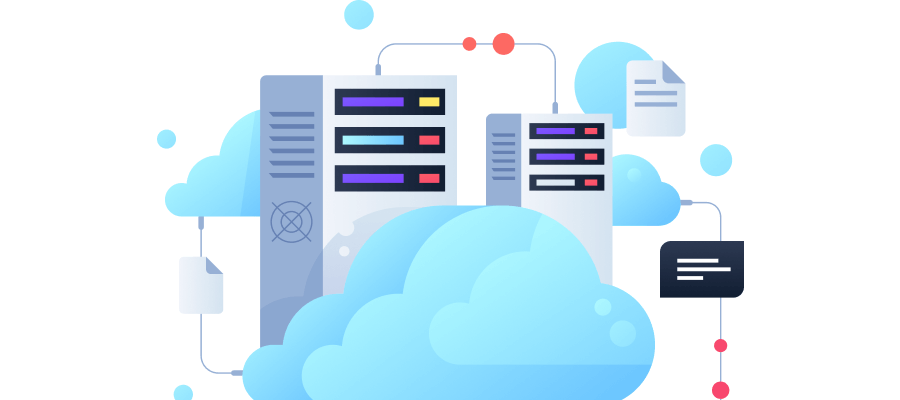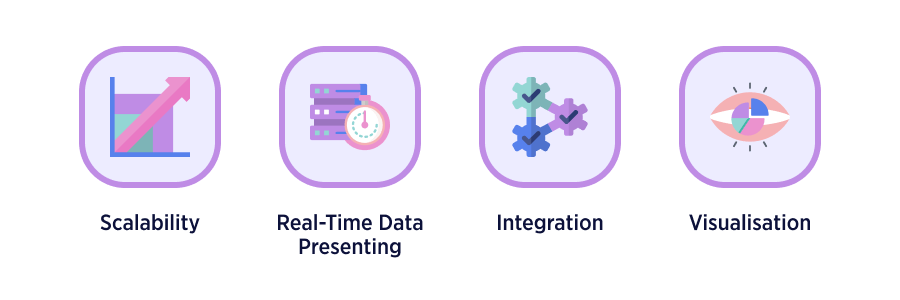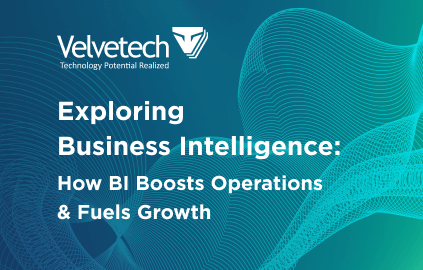Behind the scenes, an intricate web of data is being woven, holding the secrets to an unparalleled competitive edge. It’s a realm where big data reveals the nuances of customer behavior, unveils the hidden gems of market trends, and helps businesses improve their performance.
However, with data volumes surging to unprecedented levels, extracting meaningful insights can be akin to finding a needle in a haystack. This is where business intelligence (BI) comes to assist with the intricacies of big data. These two technologies help businesses identify inefficiencies, increase productivity, and unlock a new level of strategic clarity and operational efficiency.
In today’s article, we are going to delve into the essence of big data and business intelligence collaboration. Particularly, we will explore:
- The Intersection of Big Data and Business Intelligence
- Crucial Metrics to Track for Robust Data Analytics
- Must-Have Capabilities of BI Tools
BI for Business
Find out the secrets of how business intelligence boosts operations and what BI tools and practices drive data analysis.
Transforming Big Data Analytics with Business Intelligence
You’ve probably come across numerous discussions on the synergy between business intelligence and big data. Yet, we’ll give a quick reminder of what they are so we’re all on the same page.
Big data means enormously big sets of information that come in all sorts of types, arrive really quickly, and need to be checked for accuracy. Typically, traditional data management tools can’t handle these large and complex datasets. However, for sectors like healthcare, insurance, or retail that deal with a huge amount of data daily, it’s crucial to manage them effectively to achieve robust data analytics.
Here is where BI comes in handy. It stands for the tools, processes, and technologies that collect, analyze, and present relevant insight in an understandable manner.
That is to say, the intersection of big data and business intelligence serves as a powerful asset for businesses to make sense of their variables.
Without diving deeper into the nature of these technologies, let’s have a look at how companies can leverage them to reap benefits and solve possible issues along the way.
1. Data Integration and Centralization

Challenge
To harness the full potential of data assets, businesses need effective integration and centralization of diverse data sources. However, because of varying formats and quality issues, ensuring coherent integration and analysis becomes more complex.
Imagine the situation when you don’t have a single source of information. You may probably deal with incomplete and siloed data. In such a scenario, you can’t get appropriate reports and insights and thus can’t make critical business decisions.
Solution
In a world where data is spread across multiple sources, such as databases, spreadsheets, and cloud services, BI tools assist in bringing them together. These tools act like bridges between different data streams, allowing organizations to find correlations and insights that might otherwise remain hidden.
Let’s take a look at an example of how business intelligence collaborates with other tools to integrate and centralize data. For instance, BI can closely interact with CRM systems to gather and manage customer information, interactions, and transactions in one cohesive platform. By utilizing a CRM of your choice, like Salesforce or Creatio, you can track customer preferences, purchase history, and support inquiries.
Discover how Velvetech Helped the Client Integrate Computer Telephony Directly with Salesforce
Google Analytics 4 (GA4) can be another helpful tool for data integration. GA4 focuses on website and app analytics, offering an advanced understanding of user behavior and engagement.
Together with GA4 and CRMs, BI streamlines data collection and analysis, empowering businesses to make informed decisions based on an in-depth understanding of their audience.
2. Data Quality and Consistency

“Contact data ages like fish, not wine … it gets worse as it gets older, not better.”
— Gregg Thaler, Senior Director, Adobe at Medallia
Challenge
When dealing with diverse data sources, there is a high risk of encountering inconsistency and inaccuracy. Hence, ensuring data quality and reliability becomes a significant challenge. Otherwise, you will get irrelevant analysis and make inaccurate conclusions. And frankly, how can you make business-driven decisions relying on incorrect data?
Solution
Business intelligence tools streamline the process of preparing and cleansing data, which is especially vital in big data analytics. BI platforms offer functionalities to identify and rectify inconsistencies, errors, and redundancies within datasets. For example, they remove duplicate entries, correct inaccurate values, etc.
Discover how we assisted our client in Automating Data Cleansing
Furthermore, BI technologies provide mechanisms for monitoring data quality over time. This involves setting up rules and thresholds for data accuracy, completeness, and consistency. If data breaks from the established standards, the platform may send notifications. So you can take rapid action to prevent potential issues.
Watch IBM’s video to discover more about data quality and the ways to get expected outcomes.
3. Interactive Dashboards and Reports

Challenge
Understanding big data can be tough, especially for non-technical users. To make data meaningful and digestible for them, you need well-structured reports and dashboards. Otherwise, the information can be misinterpreted, leading to incorrect conclusions.
Let’s see how you can navigate such kinds of issues.
Solution
Generally, BI tools come with powerful customization options like intuitive dashboards, thus noticeably simplifying the interpretation of big data. Let’s say recently, you’ve crafted a specialized program for patients with heart-related conditions. You’ve already collected the relevant data required for personalized offerings. However, your marketers are struggling to deal with them as is.
By investing in reports and dashboards, which typically offer BI tools, you can help your team unlock the full potential of data analytics to craft a robust targeted marketing.
But the benefits of dashboards and reports go beyond merely supporting your marketers. For example, BI tools can play a crucial role in fostering a culture of data literacy across your company.
As a result, your employees will be able to create personalized boards and share them across the whole staff. And having access to the same boards will allow your team to have a single source of truth. Additionally, it will bring better collaboration with data.
4. Real-Time Data Monitoring

Challenge
In this ever-changing world, there is no need to speak about the importance of timely decisions. Of course, it is crucial to get accurate insights, but if they aren’t given on time, you risk being kicked out of the competition.
Solution
Fortunately, today BI provides tools for real-time big data analytics. Thus, enabling businesses to capitalize on opportunities and navigate the dynamic market with confidence.
Check key Data Analysis Types for Better Decision-Making
One of the tools that you can leverage is Microsoft’s Power BI. It integrates with various data sources, including real-time streaming data. As a result, users can build interactive visualizations and reports that reflect changes in data in real time.
5. Automated Insights

Challenge
Big data often involves massive and complex datasets that can be time-consuming and resource-intensive to analyze manually. Additionally, there is a high risk of mistakes and inconsistencies, leading to inaccurate insights.
Solution
Many modern BI platforms incorporate automation and machine learning tools powered by artificial intelligence to enhance the efficiency of data analysis. Typically, automation has numerous benefits to offer — from reducing human errors to identifying patterns and trends within large datasets.
Discover more on how AI Can Bring Innovation to Your Business
Automation goes beyond reducing the risk of manual errors and discovering insights that might have otherwise been missed. It can also detect some anomalies and send a notification to the staff. For example, automated security systems can continuously monitor network traffic. In case of any unusual or potentially malicious activities, they can notify the information security department.
6. Cost-Effectiveness

Challenge
It’s not a secret that data analysis requires investment. Especially, if you choose to build a custom analytics platform to handle big data needs. This process involves extensive coding, strong infrastructure, and experienced specialists like data engineers. Obviously, it’s not going to be a cheap pleasure.
Solution
Cost-effectiveness is one of the reasons why BI solutions are becoming more and more popular in big data analytics. Typically, it comes with pre-built functionalities and tools like data integration, visualization, and reporting. On top of that, these tools are quite user-friendly and easy to leverage, so you can analyze information quite fast.
Thanks to this significant benefit of business intelligence, there is no need to build analytical solutions from scratch.
7. Resource Optimization

Challenge
Skilled professionals are not the only factor that can eat up a large portion of a business’s budget. There are also several resource-related costs to consider. For example, if you manage supply chains, you likely need to analyze costly elements like delivery routes, fuel consumption, high energy usage, and more to identify inefficiencies and eliminate them.
Having relevant big data at your fingertips is only half the battle. Analyzing them can be pretty challenging.
Solution
Fortunately, business intelligence can become a valuable asset for data analytics in this regard. So, once you collect the needed variables, process them through BI tools and let them do the rest.
Specifically, BI solutions integrated with machine learning and predictive models serve best to forecast potential issues based on historical data. Moreover, BI customization tools that we’ve already mentioned (real-time tracking and intuitive dashboards) become a perfect addition to make data more understandable and quickly accessible.
Even better, you can create dashboards for each metric you want to track. This will give you a big picture of how your resources are being used, thus empowering you to optimize them.
8. Risk Management and Fraud Detection

Challenge
Needless to say, appropriate risk mitigation and fraud detection are vital for data analytics. However, managing risks and detecting fraud in the realm of big data pose significant challenges.
If you do not take timely actions to prevent the above issues, you can undermine the reliability and trustworthiness of data. It can impact both the business bottom line and threaten the credibility of your organization.
Solution
You may probably think that BI tools can identify unusual patterns and anomalies that might signify fraudulent behavior. And you are quite right.
By integrating business intelligence with big data, organizations can collect historical information from diverse sources like mobile apps, web platforms, and IoT devices. Monitoring these data enables the detection of potential suspicious activity.
Using ML and predictive modeling can assist in building better risk management in big data analytics. They help uncover patterns, correlations, and trends within databases. As a result, businesses can forecast possible threats and harness them effectively.
Discover how Predictive Analytics Can Be Beneficial for Businesses
9. Data Governance and Compliance

Challenge
Data governance and compliance are critical components of big data and business intelligence, which ensure data accuracy, security, and regulatory adherence. To be more precise, it involves setting up rules, procedures, roles, and responsibilities that define how information should be managed. Its goal is to verify that everyone understands how to properly handle data.
It is also important to make sure that data is collected in accordance with applicable regulations and industry standards. Otherwise, non-compliance can lead to severe legal and financial consequences. As a result, your organization can jump into legal and reputational risks.
Solution
Many BI tools, like Tableau and Power BI, provide features for data governance and compliance. This ensures your data management is in line with regulations and industry standards. Consequently, it prevents costly breaches and penalties for non-compliance.
Explore Key Components of Effective Data Management
Data governance and compliance can also foster a culture of transparency and accountability within your company. On top of that, providing reliable insights will positively affect your organization’s reputation.
10. Cloud Connectivity

Challenge
With effective cloud connectivity, you can harness the full potential of cloud resources without sacrificing data accessibility. Though cloud technologies bring scalability, they come with some challenges. Here, it is vital to ensure data safety and security during transfer, effectively manage costs, address latency issues, etc.
Keep reading to discover How to Optimize Cloud Costs
Solution
BI solutions can significantly improve data security by seamlessly integrating with cloud technologies, such as Amazon Web Services, Google Cloud, or Microsoft Azure. Business intelligence systems bring their own set of built-in security measures, such as access controls and encryption. They complement the cloud’s security infrastructure.
As a result, businesses can easily define and harness issues like potential threats or unauthorized access. Simply put, by combining BI solutions with cloud technology, you can address security measures and effectively reduce potential issues in a timely manner.
BI for Business
Find out the secrets of how business intelligence boosts operations and what BI tools and practices drive data analysis.
Key Capabilities Your BI Tool Needs to Effectively Process Big Data

Given the immense role business intelligence tools play in making huge datasets digestible, you might not question their importance. However, do not take BI tools for granted. Here are the key capabilities they should have to help you get straight to the point:
-
Scalability: When it comes to processing big data, a scalable solution has no alternative. That is to say, your BI tool should be capable of handling large volumes of data without compromising your systems’ speed and performance.
-
Real-Time Data Presenting: We’ve already touched on the importance of getting real-time insights to make accurate business decisions. Consequently, your BI tool should have this feature.
-
Integration: To ensure smooth data flow, business intelligence solutions should seamlessly integrate with other systems like cloud services, machine learning tools, and databases. Precisely these integrations make it possible to smoothly handle data from different sources and process it effectively.
-
Visualization: This feature is like the heart of every BI tool. Intuitive dashboards empower people, even those with no analytical skills at all, to gain a solid understanding of the data.
Leverage Your Big Data with BI Capabilities
As we see, BI and big data complement each other, providing valuable insights and advantages for businesses. Now you know how business intelligence can serve as a helping hand for big data analytics to support you in mitigating issues and improving your business performance.
Each business requirement can vary, so you need to find appropriate tools aligned with your unique needs. If you are running short of skilled professionals, Velvetech can help you build robust BI solutions and integrate big data best practices.
Reach out to us today and unleash the full potential of big data analytics.































